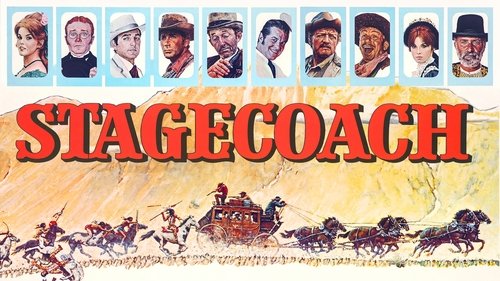jazerbini
It takes courage to make a new movie based on a story so well developed in 1939 by John Ford and starring John Wayne so magnificent, but Gordon Douglas decided to take the project forward and the result was not bad. The cast except Mike Connors and Bob Cummings (bad bad bad) is very good, especially Bing Crosby and Ann-Margret. Alex Cord is not up to John Wayne did not disappoint. It has good stage presence and fulfills its role. The final scenes, so different from its predecessor are explicit, while in 1939, John Ford chose to hide details of the final confrontation. Finally a movie is interesting and should be considered. It has more positives than negatives.
Jim
Although the 1966 remake of Stagecoach is not quite of the caliber of the 1939 version, this well done and very entertaining western is well worth a look, if only to see the beautiful color scenery in Cinemascope.Particularly notable among the cast is Bing Crosby, for once in a non singing role. His portrayal of the disgraced doctor with a taste for whiskey is a solid one, it proves that despite some of his later work (Say One for Me - 1959, etc), that the popular crooner could actually act.Alex Cord, (who is remembered for Gray Eagle - in which he portrays a Native American) is here to be seen as Ringo, and pulling a gun on the marauding "Indians" chasing the stagecoach, while trying to keep the sheriff from shooting him as an escapee, and he is in top form. Cord has not the screen presence of his predecessor in the role, John Wayne, but he carries the role off with a believable grittiness that is convincing, nonetheless.Not to demean Robert Cummings, whom I respect very much, and once worked with in films, I don't "believe" his character as the dishonest Banker, he has the right stuff, but doesn't seem able to show it off. His portrayal is nonetheless competent and does not detract from enjoyment of the film.The scenery is outstanding and Gordon Douglas and his cinematographer, William Clothier have done a fine job of giving this film an expansive and authentic look. The music is very good evoking the mood of the film as it changes from tense to exciting and back to tense. The final scenes were a trifle bloodier than the original film, and could have been less drawn out, but overall, the film works well. Just a word about the supporting cast. Ann Margaret is, as always, very fine; Red Buttons (See "Red" in Poseidon Adventure" for comparison) adds a certain comical manner to his role, which was a weak spot in the 1939 version. Mike Connors is convincing and gives the film a "familiar" feel (due to his many television roles, no doubt). Van Heflin is his usual solid self, giving his role all you would expect, but with a hint that given more to do, he would have pulled that off too. All in all, a satisfying if not top notch film, any western buff should find it very enjoyable. If you like Ernest Haycox's book (on which this film is based) "Stage to Lordsburg", you will love seeing his story in color, it really helps.
mtmv
When I first saw this movie in 1966 I was vaguely aware it was a remake but I had never seen the original. The premise - a group of vivid characters traveling together across Indian territory - is a classic formula. The key to making this work is the casting, which in this case is as perfect as the original. The interplay between Bing Crosby, as the drunken doctor, and Red Buttons, a traveling liquor salesman, is particularly delightful. Bing Crosby had a comedic style that brought out the best in anyone cast as his foil (see Bob Hope) and his performance here is worth the two hours alone. Bob Cummings, the quintessential movie nice guy, is terrific as the nervous thief on the run. Van Heflin and Slim Pickens are exactly the kind of guys you'd want at the reins of a stagecoach making a run for your life. Ann-Margret, Stefanie Powers, Mike Connors and Alex Cord do what they can with parts that were perhaps too closely patterned on the originals. Although movies of this type can at times seem contrived - with events and action occurring at the most inconvenient moments - you have to give a little leeway for dramatic license. Who would want to see a movie where nothing happens? As for the action this movie delivers - the Indian attack and chase scenes through the mountains are every bit as compelling and edge-of-your-seat thrilling as the original. And the music, by Jerry Goldsmith, is a classic in western movie scores - I remember wearing out my soundtrack album of it back in the sixties. Overall, far from being a pale imitation of the original as some have suggested, this movie stands on it's own because of the performances and crackling good direction.
hoosier1-1
I saw this movie in 1966 when it was released, and It was one of the few movies that left an impression on me all these years for several reasons. I feel the aesthetics of this movie make it worth watching. The artwork of Norman Rockwell alone is unforgettable. The music is very appropriate for the movie, not overwhelming but rustic and timed well. The scenes that were shot on location are truly breathtaking. You wont find many mattes or computer digitized images in this movie, Forget about the plot, just enjoy the artwork. But I still feel There are a few good lines in the movie. Some are even worth including in ones vocabulary.


